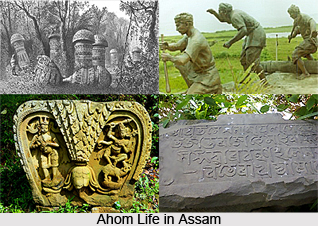 Political disturbances in Nagaon comprise the various kinds of rebellions which took place in Ahom kingdom during the regime of the young Ahom ruler Suklingphaa and his Prime Minister Purnananda Burhagohain. During 1803 CE, Purnananda released a special force to restore Ahom from the criminals who were suspected to have settled around Dharampur. This region is present between Jamuna River and Mikir Hills. Meanwhile the Moamorias gathered at a place where they had been joined by the Kacharis who belonged to the Kachari kingdom. They were sent by the ruler named Krishna Chandra. Bijoy Barmura Gohain was an Ahom prince who was also the grandson of Swargadeo Rajeswar Singha and he had assisted the group of rebels who aimed to become the king.
Political disturbances in Nagaon comprise the various kinds of rebellions which took place in Ahom kingdom during the regime of the young Ahom ruler Suklingphaa and his Prime Minister Purnananda Burhagohain. During 1803 CE, Purnananda released a special force to restore Ahom from the criminals who were suspected to have settled around Dharampur. This region is present between Jamuna River and Mikir Hills. Meanwhile the Moamorias gathered at a place where they had been joined by the Kacharis who belonged to the Kachari kingdom. They were sent by the ruler named Krishna Chandra. Bijoy Barmura Gohain was an Ahom prince who was also the grandson of Swargadeo Rajeswar Singha and he had assisted the group of rebels who aimed to become the king.
The Ahom troops were then ordered by Kamaleswar Singha to march against the rebels at Guwahati. The armies from Guwahati joined the troops sent by Purnananda Burhagohain from Jorhat who then congregated at the region of Roha-Chowki. Thereafter, the Ahom forces collectively fought against the combined strength of the Kacharis at Jamunamukh and Moamorias and defeated them. However the enemies raided and burnt the neighbouring villages mercilessly near the town of Nagaon. Many villages joined the rebels. Since the Ahom armies were unaware about the secretive developments designed by the rebels, the Ahom troops crossed the Kapili River and Kalang River, and made attempts to launch an attack on the enemy.
They then ambushed the Ahom forces and thus commenced a violent warfare between the rebel groups and the Ahom forces. As the forces on the side of the Ahom troops started running out on their supplies of fresh war equipments, they had no other choice but to retreat from the battlefield. They had lost about 540 men and several guns. Finally, the common masses were forced to surrender to the Moamorias, especially in the area surrounded by Micha River, Brahmaputra River and the Kajali River. Chieftains of Tiwa tribals or `Lalung` which constitutes the current-day Marigaon District also conspired against the Ahoms by joining the rebels. The Ahoms addressed them as `Raja Powalis` or `subordinate rulers`.






































